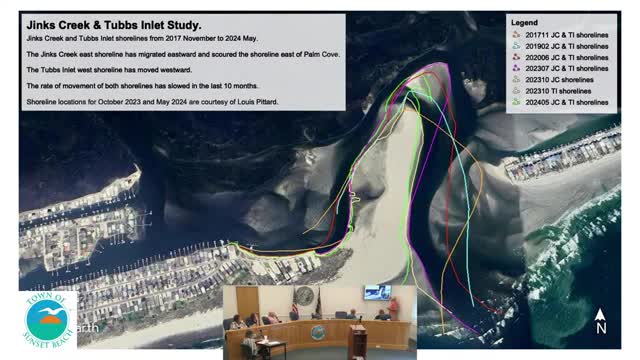Shoreline Erosion Sparks Urgent Environmental Concerns
June 20, 2024 | Town of Sunset Beach, Brunswick County, North Carolina

This article was created by AI summarizing key points discussed. AI makes mistakes, so for full details and context, please refer to the video of the full meeting. Please report any errors so we can fix them. Report an error »

In a recent government meeting, officials discussed significant changes in the shoreline and waterways of the region, particularly focusing on the movement of channels and erosion patterns affecting local beaches and inlets. The meeting highlighted the ongoing migration of the channel near Oceania Beach, which has shifted towards the center between two islands over the past several years. This movement raises concerns about potential erosion along the shoreline, particularly at Palm Cove, where severe erosion has already been observed.
Experts noted that the channel's oscillating movement could be influenced by various factors, including the angle of incoming ocean currents. While the current trend shows a reduction in erosion due to the channel's alignment, there remains apprehension about future hurricanes and their potential impact on the shoreline.
The meeting also addressed the challenges posed by the accumulation of sand in navigable waters, particularly at low tide, which complicates access for boaters. The growth of grass islands in the area was acknowledged, with officials emphasizing the importance of these habitats and the restrictions on disturbing them.
Additionally, the Twin Lakes Conservation Association was discussed, with a subcommittee providing updates on ongoing research and grant opportunities aimed at preserving the Twin Lakes area. The subcommittee's efforts include collaboration with the North Carolina Cooperative Extension to gather insights and recommendations for best practices in conservation.
As the meeting concluded, officials expressed their commitment to monitoring the evolving landscape and addressing the environmental challenges posed by natural changes and human activities. The next steps include a presentation to the town council to further discuss findings and strategies for managing the region's waterways and habitats.
Experts noted that the channel's oscillating movement could be influenced by various factors, including the angle of incoming ocean currents. While the current trend shows a reduction in erosion due to the channel's alignment, there remains apprehension about future hurricanes and their potential impact on the shoreline.
The meeting also addressed the challenges posed by the accumulation of sand in navigable waters, particularly at low tide, which complicates access for boaters. The growth of grass islands in the area was acknowledged, with officials emphasizing the importance of these habitats and the restrictions on disturbing them.
Additionally, the Twin Lakes Conservation Association was discussed, with a subcommittee providing updates on ongoing research and grant opportunities aimed at preserving the Twin Lakes area. The subcommittee's efforts include collaboration with the North Carolina Cooperative Extension to gather insights and recommendations for best practices in conservation.
As the meeting concluded, officials expressed their commitment to monitoring the evolving landscape and addressing the environmental challenges posed by natural changes and human activities. The next steps include a presentation to the town council to further discuss findings and strategies for managing the region's waterways and habitats.
View full meeting
This article is based on a recent meeting—watch the full video and explore the complete transcript for deeper insights into the discussion.
View full meeting
